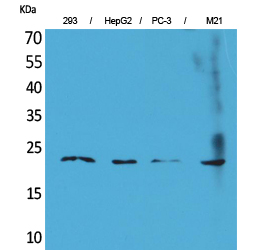FGF-6 Polyclonal Antibody
- Catalog No.:YT5169
- Applications:WB;ELISA
- Reactivity:Human;Mouse;Rat
- Target:
- FGF-6
- Fields:
- >>MAPK signaling pathway;>>Ras signaling pathway;>>Rap1 signaling pathway;>>Calcium signaling pathway;>>PI3K-Akt signaling pathway;>>Regulation of actin cytoskeleton;>>Pathways in cancer;>>Chemical carcinogenesis - receptor activation;>>Melanoma;>>Breast cancer;>>Gastric cancer
- Gene Name:
- FGF6
- Protein Name:
- Fibroblast growth factor 6
- Human Gene Id:
- 2251
- Human Swiss Prot No:
- P10767
- Mouse Gene Id:
- 14177
- Mouse Swiss Prot No:
- P21658
- Immunogen:
- The antiserum was produced against synthesized peptide derived from the C-terminal region of human FGF6. AA range:159-208
- Specificity:
- FGF-6 Polyclonal Antibody detects endogenous levels of FGF-6 protein.
- Formulation:
- Liquid in PBS containing 50% glycerol, 0.5% BSA and 0.02% sodium azide.
- Source:
- Polyclonal, Rabbit,IgG
- Dilution:
- WB 1:500 - 1:2000. ELISA: 1:20000. Not yet tested in other applications.
- Purification:
- The antibody was affinity-purified from rabbit antiserum by affinity-chromatography using epitope-specific immunogen.
- Concentration:
- 1 mg/ml
- Storage Stability:
- -15°C to -25°C/1 year(Do not lower than -25°C)
- Other Name:
- FGF6;HST2;HSTF2;Fibroblast growth factor 6;FGF-6;Heparin secretory-transforming protein 2;HST-2;HSTF-2;Heparin-binding growth factor 6;HBGF-6
- Observed Band(KD):
- 23kD
- Background:
- The protein encoded by this gene is a member of the fibroblast growth factor (FGF) family. FGF family members possess broad mitogenic and cell survival activities, and are involved in a variety of biological processes, including embryonic development, cell growth, morphogenesis, tissue repair, tumor growth and invasion. This gene displayed oncogenic transforming activity when transfected into mammalian cells. The mouse homolog of this gene exhibits a restricted expression profile predominantly in the myogenic lineage, which suggested a role in muscle regeneration or differentiation. [provided by RefSeq, Jul 2008],
- Function:
- function:Can transform NIH 3T3 cells. Exhibits strong mitogenic and angiogenic properties.,similarity:Belongs to the heparin-binding growth factors family.,tissue specificity:Leukemia cell lines with platelet/ megakaryocytic differentiation potential.,
- Subcellular Location:
- Secreted, extracellular space.
- Expression:
- Leukemia cell lines with platelet/ megakaryocytic differentiation potential.
Large-Scale Expression, Purification of Bioactive Recombinant Human FGF6 in E. coli and the Mechanisms of Its Myocardial Protection. International Journal of Peptide Research and Therapeutics 2017 May 10 WB Rat 1:1000 H9c2 cell
The FGF6 amplification mutation plays an important role in the progression and treatment of malignant meningioma Translational Oncology Ruihao Liang WB Human IOMM-LEE cell,CH157MN cell
- June 19-2018
- WESTERN IMMUNOBLOTTING PROTOCOL
- June 19-2018
- IMMUNOHISTOCHEMISTRY-PARAFFIN PROTOCOL
- June 19-2018
- IMMUNOFLUORESCENCE PROTOCOL
- September 08-2020
- FLOW-CYTOMEYRT-PROTOCOL
- May 20-2022
- Cell-Based ELISA│解您多样本WB检测之困扰
- July 13-2018
- CELL-BASED-ELISA-PROTOCOL-FOR-ACETYL-PROTEIN
- July 13-2018
- CELL-BASED-ELISA-PROTOCOL-FOR-PHOSPHO-PROTEIN
- July 13-2018
- Antibody-FAQs
- Products Images

- Western Blot analysis of 293, HepG2, PC-3, M21 cells using FGF-6 Polyclonal Antibody. Secondary antibody(catalog#:RS0002) was diluted at 1:20000

- Western blot analysis of lysate from 293 cells, using FGF6 Antibody.



